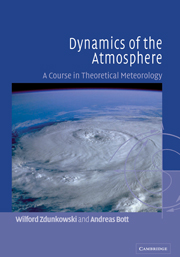Book contents
- Frontmatter
- Contents
- Preface
- Part 1 Mathematical tools
- Part 2 Dynamics of the atmosphere
- 1 The laws of atmospheric motion
- 2 Scale analysis
- 3 The material and the local description of flow
- 4 Atmospheric flow fields
- 5 The Navier–Stokes stress tensor
- 6 The Helmholtz theorem
- 7 Kinematics of two-dimensional flow
- 8 Natural coordinates
- 9 Boundary surfaces and boundary conditions
- 10 Circulation and vorticity theorems
- 11 Turbulent systems
- 12 An excursion into spectral turbulence theory
- 13 The atmospheric boundary layer
- 14 Wave motion in the atmosphere
- 15 The barotropic model
- 16 Rossby waves
- 17 Inertial and dynamic stability
- 18 The equation of motion in general coordinate systems
- 19 The geographical coordinate system
- 20 The stereographic coordinate system
- 21 Orography-following coordinate systems
- 22 The stereographic system with a generalized vertical coordinate
- 23 A quasi-geostrophic baroclinic model
- 24 A two-level prognostic model, baroclinic instability
- 25 An excursion concerning numerical procedures
- 26 Modeling of atmospheric flow by spectral techniques
- 27 Predictability
- Answers to Problems
- List of frequently used symbols
- References and bibliography
- Index
22 - The stereographic system with a generalized vertical coordinate
Published online by Cambridge University Press: 05 June 2012
- Frontmatter
- Contents
- Preface
- Part 1 Mathematical tools
- Part 2 Dynamics of the atmosphere
- 1 The laws of atmospheric motion
- 2 Scale analysis
- 3 The material and the local description of flow
- 4 Atmospheric flow fields
- 5 The Navier–Stokes stress tensor
- 6 The Helmholtz theorem
- 7 Kinematics of two-dimensional flow
- 8 Natural coordinates
- 9 Boundary surfaces and boundary conditions
- 10 Circulation and vorticity theorems
- 11 Turbulent systems
- 12 An excursion into spectral turbulence theory
- 13 The atmospheric boundary layer
- 14 Wave motion in the atmosphere
- 15 The barotropic model
- 16 Rossby waves
- 17 Inertial and dynamic stability
- 18 The equation of motion in general coordinate systems
- 19 The geographical coordinate system
- 20 The stereographic coordinate system
- 21 Orography-following coordinate systems
- 22 The stereographic system with a generalized vertical coordinate
- 23 A quasi-geostrophic baroclinic model
- 24 A two-level prognostic model, baroclinic instability
- 25 An excursion concerning numerical procedures
- 26 Modeling of atmospheric flow by spectral techniques
- 27 Predictability
- Answers to Problems
- List of frequently used symbols
- References and bibliography
- Index
Summary
In the previous chapter we introduced the vertical coordinate η to handle orographic effects in mesoscale models. In the synoptic-scale models we are going to replace the height coordinate z which extends to infinity by a generalized vertical coordinate ξ. The introduction of ξ is motivated by the fact that we cannot integrate the predictive equations using z as a vertical coordinate to infinitely large heights. Replacing z by the atmospheric pressure p, for example, results in a finite range of the vertical coordinate. We will see that another advantage of the (x, y, p)-coordinate system is that the continuity equation is time-independent. There are other specific coordinate systems that we are going to discuss. Therefore, it seems of advantage to first set up the atmospheric equations in terms of the unspecified generalized vertical coordinate ξ. Later we will specify ξ as desired. We wish to point out that the introduction of the generalized coordinate is of advantage only if the hydrostatic equation is a part of the atmospheric system.
We will briefly state the consequences of the transformation from the stereographic (x, y, z)-coordinate system to the stereographic (x, y, ξ)-coordinate system, which henceforth will be called the ξ system.
- Type
- Chapter
- Information
- Dynamics of the AtmosphereA Course in Theoretical Meteorology, pp. 572 - 590Publisher: Cambridge University PressPrint publication year: 2003

